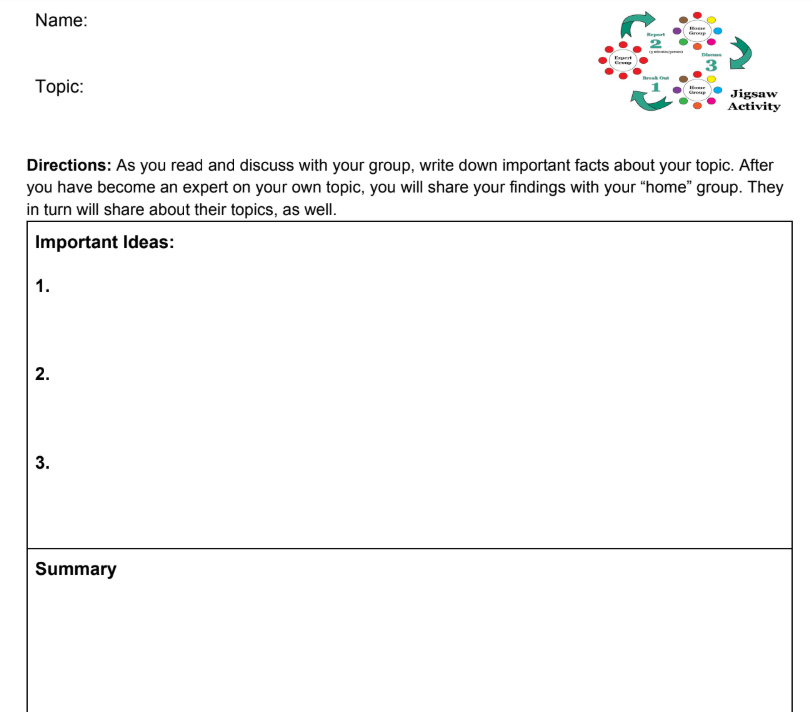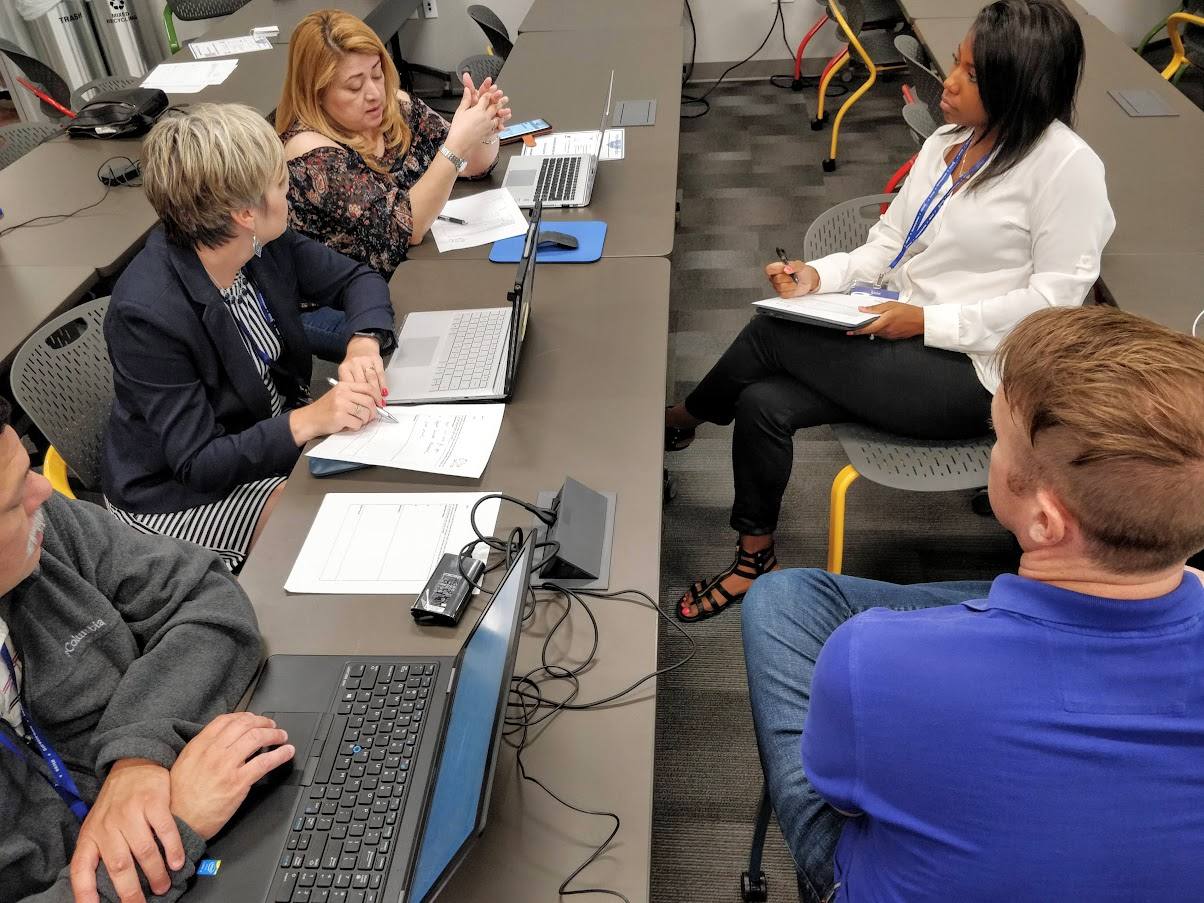“I was using jigsaw with my students before,” said the science teacher at a private school. “Now that I know its effect size, I’m going to be using it even more.” The insight about the jigsaw strategy popped up after discussing John Hattie’s meta-analysis. If you’re not familiar with it, he analyzed a lot of research. His meta-analyses identified the effect size of instructional strategies used in schools today. Let’s take a moment to see how jigsaw works and in the context of educational technology.
The Jigsaw Method
“The Jigsaw Method is a teaching strategy. It is useful for organizing student group work,” says Jordan Catapano. “It helps students collaborate and rely on one another.” John Hattie found the jigsaw method to have an effect size of 1.2. What does that mean? Consider that the average growth any student experiences over an academic year is .40. This means that using jigsaw in a consistent manner can accelerate student growth. Students in your classroom will see greater than one year’s growth with the jigsaw.
As I was working on my PBL with Minecraft: Education Edition session, I realized I had a lot of resources to share. I asked myself, “Would the jigsaw method work well enough to get the job done?” Before I share how that worked out, it might be worth reviewing how the jigsaw method works.
Douglas Fisher and Nancy Frey suggest there are three types of jigsaw methods. After reviewing their list, I realize that they are right.
Approach #1: Jigsaw as Divide and Conquer (One-Step Jigsaw)
This was my first introduction to the term “jigsaw.” This ineffective application of the label serves as a way to divide a long article into pieces. Each group member takes a piece, then summarizes it for the small group (or large group).
Fisher and Frey share their opinion about this:
This “one-step” approach isn’t a jigsaw; it’s a divide-and-conquer approach to text. When teachers experience “jigsaw” in this way, they’re likely to replicate it incorrectly in their classrooms. Harm may be done as less effective readers share misinformation with the group and everyone’s understanding is compromised.
This approach may not be the best one to replicate.
Approach #2: Home and Expert Groups (Two-Step Jigsaw)
Only this summer did I attempt the home and expert groups approach to jigsaw. The process involved grouping students into “home” groups. Then, students chose one resource of the available list. Once students decided on their resource, they formed up into “expert” groups. The expert groups worked to plumb the depths of the same article. Then they discussed their takeaways with each other in their respective home groups. Here’s a link to the organizer my students used in Google Docs format.

This approach falls short as well, although not as much as the first approach. Frey and Fisher point out the following:
In this type of activity, learners still don’t have the opportunity to discuss how their assigned part fits within the whole text; groups just report on the particular section they read. And the critical thinking that’s accomplished through analysis and synthesis doesn’t happen.
How do you get students to do more than report on the particular section they have read? More important, how do you make analysis and synthesis to happen?
Approach #3: True Jigsaw (Three-Step Jigsaw)
The critical third step of the three-step jigsaw involves students returning to their expert groups. Once back in expert groups, they discuss how their part fits into the whole. Fisher and Frey describe it in this way:
In the third phase of the jigsaw, students return to their expert groups and discuss how their passage fits into the whole text, based on their discussions with their home group. The point of this third phase is to have students engage in a part-to-whole conversation in which they arrive at a deeper understanding about the text and its implications.
Students think about their thinking (metacognition) and synthesize and analyze ideas contained within the complete text. This process requires that students listen carefully to their peers and analyze the ways in which each part contributes to the entire text.
As you can see, step three of the this jigsaw approach involves heavy lifting. As such, I see the phases of movement as follows now:
- Divide students into home groups to split up portions of text or resources.
- Set up a way for students to group according to expert groups to explore their specific area.
- Regroup into home groups to discuss findings.
- Split into expert groups to consider the whole in light of specific area.
This constant movement of students from one group to another can be awkward. But let’s not forget how important movement is to the human brain and learning efforts. Without this heavy lifting, the jigsaw method in use may not be as effective. As you reflect on how you are using jigsaw in your classroom, which approach have you taken?

Reflections: The Jigsaw Method in My Workshop
In my face-to-face workshop, I relied on the two-step jigsaw. Rather than use a single resource split up into passages, I shared resources relevant to a theme. The theme? PBL in the Minecraft: Education Edition classroom. As I implemented it, students did not achieve the critical third level, but the activity did achieve my intended goal. Some of the participants were quite forceful in sharing their perspectives. You can see how this activity appears in my session materials. Visit Activity #1 – Exploring Possibilities to see it in action.
Some revisions I would make now that I know about the three-step jigsaw include:
- Include a quiz or performance task at the end of the two-step version of the jigsaw. This would fall into step right after phase three movement.
- Use some kind of metacognitive aid or scaffold (concept map?) to capture student discussion in the phase four movement. That’s the third step of the three-step jigsaw. In this phase, students move back into expert groups to discuss their learning in context of the whole.
What are your thoughts on the jigsaw approach and its use for professional learning or in your classroom?


4 comments
Hi Miguel, thank you for this thoughtful look inside your efforts to facilitate adult learning! It’s really thought provoking. My main comment in response is to wonder about how teachers of children can transfer their knowledge and skills to teach adults. There’s lots of overlap (e.g., classroom management, questioning skills, lesson design thinking, balancing between content-area expert and facilitator of others’ learning) for sure that provides value to adult learning sessions. Hattie’s work was a meta-analysis of K-12 research, though, and so I am wondering: what might be the effect size might be for jigsaw with adult learners? And how vital to adult learning might be these three phases? Might adult learners be better equipped to produce the same meta-cognition through self-reflection in their Home groups rather than return a second time to Expert groups? The research might be out there about Jigsaw with adults, and I’d be curious to know how/if these structures matter with adult learners.
Thank you for sharing your experience!!
Derek, howdy! Thanks for your comment. Great question. Let me give it back to you to make sure I got it? I’ve taken the liberty of dividing up my response to correspond (as best I can determine it) to the questions you ask. Those questions are:
1. Can classroom teachers transfer what they do to work with adult learners?
2. How effective are Hattie’s strategies for adult learners, not K-12 where his meta-analyses were focused?
3. How effective is the jigsaw method with adult learners?
4. How better-equipped are adults with meta-cognition through self-reflection in their home groups?
You’ve asked some great questions and I’ll do my best to respond, even when I may not know what the heck I’m talking about.
🙂
1-Andragogy and Adult Learners
You’re asking, “How can teachers working primarily with children transfer their knowledge and skills to teach adults?” In a lot of ways, this makes me think of educators who have been classroom teachers stepping into coaching roles. In their new role, they have to facilitate professional development. Would the strategies they have developed for use with students transfer to their work with adults?
As someone who went through that transition, my response is, “Yes, it’s definitely possible.” Of course, there has to be consideration given for andragogy and all that comes with that. Dr. Cynthia Pina discusses key elements of andragogy in her dissertation, “Changing Perceptions about Professional Development: An Action Research Study Using Andragogy for Educators’ Professional Development,” online at https://commons.cu-portland.edu/cgi/viewcontent.cgi?article=1403&context=edudissertations
2-Applying Hattie’s Research Meta-Analyses to Adult Learners
In regards to Hattie’s work, I’m not sure I agree with your point that it was a meta-analysis of K-12 research alone. In fact, he cites a few studies that are from beyond K-12. In fact, Hattie says this himself:
> “Although it is the case that most are derived from the K-12 sector, there are still many from the postsecondary sector, and the
> argument of this article is that the underlying messages underlying successful innovations are quite similar across the sectors”
> Source:http://result.uit.no/basiskompetanse/wp-content/uploads/sites/29/2016/07/Hattie.pdf
So, it may be safe to say that Hattie put out a wide net that didn’t limit his research to K-12 only. This, in fact, has resulted in some of the criticism he’s faced. At which point, I like to look at the research studies using Visible Learning’s Meta X database and read the studies themselves. You can “google” anything these days, including copies of the actual studies. To be honest, I have managed to find every study I have gone after. Whether it makes sense or not, well, to apply it to K-12, that’s the argument of effect sizes and category errors (http://www.ollielovell.com/errr/adriansimpson/) that others more familiar with research methodologies than I have examined.
3-Effect of Jigsaw Approach’s Three Phases on Adult Learners
The Jigsaw approach has a significant effect size. Jigsaw method ([read more](https://www.jigsaw.org/pdf/JigsawBasics.pdf)) has a lot of proponents and research to support it. When looking at various strategies that work, a question to ask is, “Would this work with adult learners?” The answer for me, based on my own observation, was, “Yes, it appeared to and didn’t seem to impede knowledge acquisition.” A quick search online for research on the use of the jigsaw approach with adult learners seems to suggest this:
Using the Jigsaw Technique to Teach Clinical Controversy
(Feedback from HigherEd folks)
You may want to look for some more info on the impact, but I suspect that as Hattie says above, this strategy works.
4-Social Metacognition and Jigsaw
“Social metacognition distributes metacognitive responsibilities across group members, makes metacognition visible to facilitate learning, and improves individual cognitive processes” says this research study on the subject. I imagine that jigsaw’s approach where participants go back to the expert groups to share their homegroup’s reflections falls into this category of “social metacognition.”
Your question, whether you can get the same results via self-reflection as what jigsaw participants do when they do their final return to expert groups, well, I’m not sure. That might make for an interesting action research study. Benefits may vary with how familiar adults are with meta-cognition, jigsaw, and the quality of relationships in the group. Relationships are improved among K-12 students jigsaw homegroup, so we may see similar effects for adults. More study is needed.
Thanks for such great questions, Derek!